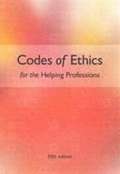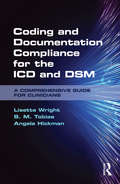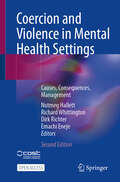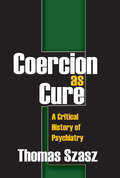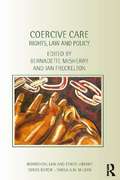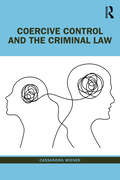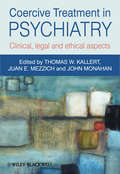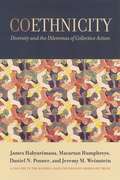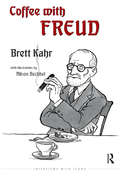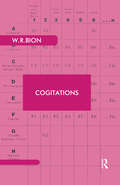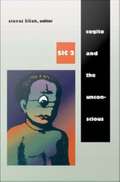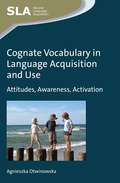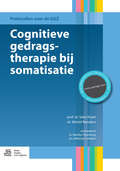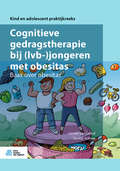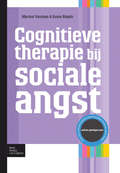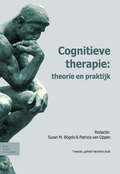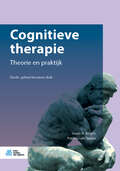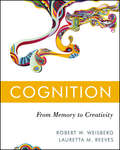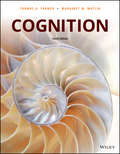- Table View
- List View
Codes Of Ethics For The Helping Professions
by Gerald Corey Marianne Schneider CoreyThis brief supplement offers students a handy resource that contains codes of ethics for the various professional organizations.
Coding and Documentation Compliance for the ICD and DSM: A Comprehensive Guide for Clinicians
by Lisette Wright S. M. Tobias Angela HickmanCoding and Documentation Compliance for the ICD and DSM provides professionals, professors, and students with a logical and practical way of understanding a difficult topic in healthcare for the clinician: coding. Established professionals will find the tools they need to comply with the ICD series, HIPAA, and integrated care models. Professors and students will appreciate having a systemized, standardized approach to teaching and learning the more complex aspects of ICD compliance. The interplay between the ICD and DSM manuals is also explicated in clear terms.
Coercion and Violence in Mental Health Settings: Causes, Consequences, Management
by Richard Whittington Dirk Richter Nutmeg Hallett Emachi EnejeThis book aims to provide a state-of-the-art overview of the contexts, causes and treatments that relate to the reduction of coercion and the prevention of violence in mental health settings. The objective of this new edition in Open Access is to integrate theoretical explanations, empirical findings and practical solutions on the topic from many countries and diverse professional contexts. A large proportion of the text is concerned with practical and applied guidance for practitioners and others based on a clear understanding of conceptual and theoretical issues. Significantly enriched by the contributions of lived experience editors and co-authors, this edition brings authentic, new perspectives that deepen its relevance and impact. There is extensive use of case studies drawn from practice and the media to enliven the discussion. The scope of the book is intended to go beyond a reductionist medical/biological orientation on coercion and violence in mental health by integrating this within broader psychological and social frameworks. It includes new relevant contributions from nursing, psychology, psychiatry and sociology. The language of the book is clear and understandable to a broad audience whilst offering new knowledge for researchers and other specialists.
Coercion and its Fallout
by Murray SidmanThis book explores coercion, what it is, and how it rules our everyday lives in today's society. Coercion is in our actions, our bosses actions towards us, nature towards human beings, and in the teachers to their students and vice versa. Ways people deal with coercion are also discussed including escaping, dropping out, avoidance, and countercoercion also known as fighting back. The authors also present information and research on how effective positive reinforcement can be in changing how we react to coercion. Valuable book for anyone wanting to understand positive reinforcement and punishment.
Coercion as Cure: A Critical History of Psychiatry
by Frank VillafanaUnderstanding the history of psychiatry requires an accurate view of its function and purpose. In this provocative new study, Szasz challenges conventional beliefs about psychiatry. He asserts that, in fact, psychiatrists are not concerned with the diagnosis and treatment of bona fide illnesses. Psychiatric tradition, social expectation, and the law make it clear that coercion is the profession's determining characteristic.Psychiatrists may "diagnose" or "treat" people without their consent or even against their clearly expressed wishes, and these involuntary psychiatric interventions are as different as are sexual relations between consenting adults and the sexual violence we call "rape." But the point is not merely the difference between coerced and consensual psychiatry, but to contrast them. The term "psychiatry" ought to be applied to one or the other, but not both. As long as psychiatrists and society refuse to recognize this, there can be no real psychiatric historiography.The coercive character of psychiatry was more apparent in the past than it is now. Then, insanity was synonymous with unfitness for liberty. Toward the end of the nineteenth century, a new type of psychiatric relationship developed, when people experiencing so-called "nervous symptoms," sought help. This led to a distinction between two kinds of mental diseases: neuroses and psychoses. Persons who complained about their own behavior were classified as neurotic, whereas persons about whose behavior others complained were classified as psychotic. The legal, medical, psychiatric, and social denial of this simple distinction and its far-reaching implications undergirds the house of cards that is modern psychiatry. Coercion as Cure is the most important book by Szasz since his landmark The Myth of Mental Illness.
Coercive Care: Rights, Law and Policy (Biomedical Law and Ethics Library)
by Bernadette McSherry Ian FreckeltonThere has been much debate about mental health law reform and mental capacity legislation in recent years with the UN Convention on the Rights of Persons with Disabilities also having a major impact on thinking about the issue. This edited volume explores the concept of ‘coercive care’ in relation to individuals such as those with severe mental illnesses, those with intellectual and cognitive disabilities and those with substance use problems. With a focus on choice and capacity the book explores the impact of and challenges posed by the provision of care in an involuntary environment. The contributors to the book look at mental health, capacity and vulnerable adult’s care as well as the law related to those areas. The book is split into four parts which cover: human rights and coercive care; legal capacity and coercive care; the legal coordination of coercive care and coercive care and individuals with cognitive impairments. The book covers new ground by exploring issues arising from the coercion of persons with various disabilities and vulnerabilities, helping to illustrate how the capacity to provide consent to treatment and care is impaired by reason of their condition.
Coercive Control and the Criminal Law
by Cassandra WienerThis book considers how a phenomenon as complex as coercive control can be criminalised. The recognition and ensuing criminalisation of coercive control in the UK and Ireland has been the focus of considerable international attention. It has generated complex questions about the "best" way to criminalise domestic abuse. This work reviews recent domestic abuse criminal law reform in the UK and Ireland. In particular, it defines coercive control and explains why using traditional criminal law approaches to prosecute it does not work. Laws passed in England and Wales versus Scotland represent two different approaches to translating coercive control into a criminal offence. This volume explains how and why the jurisdictions have taken different approaches and examines the advantages and disadvantages of each. As jurisdictions around the world review what steps need to be taken to improve national criminal justice responses to domestic abuse, the question of what works, and why, at the intersection of domestic abuse and the criminal law has never been more important. As such, the book will be a vital resource for lawyers, policy-makers and activists with an interest in domestic abuse law reform.
Coercive Treatment in Psychiatry
by John Monahan Juan E. Mezzich Thomas W. KallertCoercion is one of the most fascinating and controversial subjects in psychiatry. It is a highly sensitive, and hotly debated topic in which clinical practice, ethics, the law and public policy converge. This book considers coercion within the healing and ethical framework of therapeutic relationships and partnerships at all levels, and addresses the universal problem of how to balance safety versus autonomy when dealing with psychiatric treatment.Coercive Treatment in Psychiatry is a much needed contribution to the literature. The first three sections deal with the conceptual and clinical aspects of coercive treatment, the legal aspects and the ethical aspects of coercive treatment. In detail, these sections cover a broad spectrum of issues: coercion in institutions and in the community, coercive treatment and stigma, the definition of best practice standards for coercive treatment, de-escalation of risk situations, recent developments in mental health legislation, mental health care and patients' rights, cross-cultural perspectives on coercive treatment, historical injustice in psychiatry, and paternalism in mental health. The fourth section features users' views on coercive treatment: giving voice to an often-unheeded population. Finally, the book addresses the original topic of coercion and undue influence in decisions to participate in psychiatric research.This book presents the first comprehensive review of the issue of coercion in psychiatry. With chapters written by the leading experts in the field, many of whom are renowned as clear thinkers and experienced clinicians, it may be seen as a starting point for international discussions and initiatives in this field aiming to minimize coercion.Highly Commended in the Psychiatry section of the 2012 BMA Book Awards.
Coethnicity: Diversity and the Dilemmas of Collective Action
by Macartan Humphreys Daniel N. Posner James Habyarimana Jeremy M. WeinsteinEthnically homogenous communities often do a better job than diverse communities of producing public goods such as satisfactory schools and health care, adequate sanitation, and low levels of crime. Coethnicity reports the results of a landmark study that aimed to find out why diversity has this cooperation-undermining effect. The study, conducted in a neighborhood of Kampala, Uganda, notable for both its high levels of diversity and low levels of public goods provision, hones in on the mechanisms that might account for the difficulties diverse societies often face in trying to act collectively. The Mulago-Kyebando Community Study uses behavioral games to explore how the ethnicity of the person with whom one is interacting shapes social behavior. Hundreds of local participants interacted with various partners in laboratory games simulating real-life decisions involving the allocation of money and the completion of joint tasks. Many of the subsequent findings debunk long-standing explanations for diversity’s adverse effects. Contrary to the prevalent notion that shared preferences facilitate ethnic collective action, differences in goals and priorities among participants were not found to be structured along ethnic lines. Nor was there evidence that subjects favored the welfare of their coethnics over that of non-coethnics. When given the opportunity to act altruistically, individuals did not choose to benefit coethnics disproportionately when their actions were anonymous. Yet when anonymity was removed, subjects behaved very differently. With their actions publicly observed, subjects gave significantly more to coethnics, expected their partners to reciprocate, and expected that they would be sanctioned for a failure to cooperate. This effect was most pronounced among individuals who were otherwise least likely to cooperate. These results suggest that what may look like ethnic favoritism is, in fact, a set of reciprocity norms—stronger among coethnics than among non-coethnics—that make it possible for members of more homogeneous communities to take risks, invest, and cooperate without the fear of getting cheated. Such norms may be more subject to change than deeply held ethnic antipathies—a powerful finding for policymakers seeking to design social institutions in diverse societies. Research on ethnic diversity typically draws on either experimental research or field work. Coethnicity does both. By taking the crucial step from observation to experimentation, this study marks a major breakthrough in the study of ethnic diversity. A Volume in the Russell Sage Foundation Series on Trust
Coffee with Freud (The Interviews with Icons Series)
by Brett KahrThis is the second volume in Brett Kahr's 'Interviews with Icons' series, following on from Tea with Winnicott. Professor Kahr, himself a highly regarded psychoanalyst, turns his attention to the work of the father of psychoanalysis. The book is lavishly illustrated by Alison Bechdel, winner of the MacArthur Foundation 'Genius' Award.Sigmund Freud pays another visit to Vienna's renowned Cafe Landtmann, where he had often enjoyed reading newspapers and sipping coffee. Freud explains how he came to invent psychoanalysis, speaks bluntly about his feelings of betrayal by Carl Gustav Jung, recounts his flight from the Nazis, and so much more, all the while explaining his theories of symptom formation and psychosexuality.Framed as a 'posthumous interview', the book serves as the perfect introduction to the work of Freud while examining the context in which he lived and worked. Kahr examines his legacy and considers what Freud has to teach us. In a world where manifestations of sexuality and issues of the mind are ever more widely discussed, the work of Sigmund Freud is more relevant than ever.
Coffee, Tea, Chocolate, and the Brain (Nutrition, Brain And Behavior Ser. #Vol. 2)
by Astrid NehligCoffee, tea, and chocolate are among the most frequently consumed products in the world. The pleasure that many experience from these edibles is accompanied by a range of favorable and adverse effects on the brain that have been the focus of a wealth of recent research. Coffee, Tea, Chocolate, and the Brain presents new information on the
Cogitations
by Wilfred R. BionCogitations, the last of the posthumous publications, is a collection of occasional writings representing Bion's attempts to clarify and evaluate both his own ideas and those of others by casting them in written form and frequently addressing them to an imaginary audience. Covering a period between February 1958 and April 1979, Cogitations delves into a wide range of material - psychoanalysis and science, mathematics and logic, literature and semantics. Some form a background to Bion's theoretical development, showing the doubts and arguments leading to the ideas expressed in his books, others highlighting and detailing some of the more abstract points in them, and some exploring topics destined for books that were to remain unwritten.
Cogito and the Unconscious
by Slavoj I EkThe Cartesian cogito--the principle articulated by Descartes that "I think, therefore I am"--is often hailed as the precursor of modern science. At the same time, the cogito's agent, the ego, is sometimes feared as the agency of manipulative domination responsible for all present woes, from patriarchal oppression to ecological catastrophes. Without psychoanalyzing philosophy, Cogito and the Unconscious explores the vicissitudes of the cogito and shows that psychoanalyses can render visible a constitutive madness within modern philosophy, the point at which "I think, therefore I am" becomes obsessional neurosis characterized by "If I stop thinking, I will cease to exist. " Noting that for Lacan the Cartesian construct is the same as the Freudian "subject of the unconscious," the contributors follow Lacan's plea for a psychoanalytic return to the cogito. Along the path of this return, they examine the ethical attitude that befits modern subjectivity, the inherent sexualization of modern subjectivity, the impasse in which the Cartesian project becomes involved given the enigmatic status of the human body, and the Cartesian subject's confrontation with its modern critics, including Althusser, Bataille, and Dennett. In a style that has become familiar to Zizek's readers, these essays bring together a strict conceptual analysis and an approach to a wide range of cultural and ideological phenomena--from the sadist paradoxes of Kant's moral philosophy to the universe of Ayn Rand's novels, from the question "Which, if any, is the sex of the cogito?" to the defense of the cogito against the onslaught of cognitive sciences. Challenging us to reconsider fundamental notions of human consciousness and modern subjectivity, this is a book whose very Lacanian orthodoxy makes it irreverently transgressive of predominant theoretical paradigms. Cogito and the Unconscious will appeal to readers interested in philosophy, psychoanalysis, cultural studies, and theories of ideology. Contributors. Miran Bozovic, Mladen Dolar, Alain Grosrichard, Marc de Kessel, Robert Pfaller, Renata Salecl, Slavoj Zizek, Alenka Zupancic
Cognate Vocabulary in Language Acquisition and Use
by Agnieszka OtwinowskaThis book brings together linguistic, psycholinguistic and educational perspectives on the phenomenon of cognate vocabulary across languages. It presents a large-scale, long-term research project focusing on Polish-English cognates and their use by bilingual and multilingual learners/users of English. It discusses extensive qualitative and quantitative data to explain which factors affect a learner's awareness of cognates, how adult learners can benefit from raised awareness and whether cognate vocabulary can be used with younger learners as a motivational strategy. The work shows how cognate vocabulary can be examined from a range of methodological perspectives and provides considerable insights into crosslinguistic influences in language learning. While the focus of the studies is Polish-English cognates, the research will be of interest to anyone teaching learners of different language constellations, levels, ages and backgrounds.
Cognitieve gedragstherapie bij emetofobie: Therapeutenhandleiding (Protocollen voor de GGZ)
by Tamara LuijerEmetofobie is een vorm van angst die volgens de diagnostische criteria van de DSM V onder de specifieke fobieën valt. Het is een aanhoudende angst voor overgeven en/of anderen te zien overgeven, die overdreven of onredelijk is (American Psychiatric Association, 2013).Het behandelprotocol bij emetofobie beschrijft een cognitieve gedragstherapeutische behandeling van 15 sessies. Volgens de ggz-richtlijnen en vanuit een verscheidenheid aan casus-beschrijvingen is cognitieve gedragstherapie in combinatie met exposure de voorkeursbehandeling van emetofobie (LSMR, 2003; Keyes, Gilpinb, & Veale, 2018; Wolitzky-Taylor, Horowitz, Powers, & Telch, 2008). Middels theorie en opdrachten in het werkboek leert de patiënt inzicht krijgen in hoe de emetofobie is ontstaan, leert hij helpend denken, met het gevoel van misselijkheid om te kunnen gaan en stap voor stap zijn angsten aan te pakken.
Cognitieve gedragstherapie bij somatisatie (Protocollen voor de GGZ)
by Sako Visser Michiel ReindersDit boek biedt een protocol voor de behandeling van cliënten met onverklaarde lichamelijke klachten en sensaties (somatoforme stoornissen). Het is bedoeld voor behandelaars binnen de GGZ. Somatoforme stoornissen zijn stoornissen waarbij mensen langdurige lichamelijke klachten hebben waarvoor geen lichamelijke oorzaak gevonden kan worden. Meestal zijn er bijkomende psychische en sociale klachten en problemen. Het protocol kan flexibel worden gbruikt, afhankelijk van het klachtenpatroon van de patiënt. De invulling van de twaalf sessies binnen het protocol is afhankelijk van de individuele patiënt. In de eerste twee sessies wordt de problematiek van de patiënt in kaart gebracht aan de hand van een cognitief gedragstherapeutisch model. Deze analyse geeft richting aan de invulling en de aandacht in de daarop volgende sessies. Bij het boek is aanvullend materiaal beschikbaar. Het bestaat uit fragmenten met de volgende onderwerpen: Inventarisatie van de klachten en gevolgen; Cognitieve herstructurering; Exposure en responspreventie; Reactivatie; Nieuwe copingvaardigheden en Omgaan met terugval.
Cognitieve gedragstherapie bij volwassenen met AD: Handleiding voor therapeuten (Protocollen voor de GGZ)
by Sanne E. VinkDit behandelprotocol is bedoeld voor professionals binnen de ggz die volwassenen met AD(H)D behandelen. Het helpt om de meest voorkomende problemen aan te pakken waar zij dagelijks tegenaan lopen, bijvoorbeeld bij het plannen, organiseren en opruimen. Het uitgangspunt van Cognitieve gedragstherapie bij volwassenen met AD(H)D is dat het veranderen van disfunctionele gedachten noodzakelijk is voor het aanleren van vaardigheden. Door het aanpassen van deze gedachten wordt de weg voor cliënten vrijgemaakt om succesvol te zijn in het aanpakken van taken en het organiseren van het leven. Cognitieve gedragstherapie bij volwassenen met AD(H)D heeft twee unieke eigenschappen. Allereerst zijn er meerdere disfunctionele gedachten geïdentificeerd die specifiek bij volwassenen met AD(H)D voorkomen en die het aanleren van vaardigheden belemmeren. Tot dusver richten behandelingen zich voornamelijk op psycho-educatie en het aanleren van vaardigheden. Een ander uniek punt is dat dit behandelprotocol de AD(H)D-symptomen inzet als meetinstrument om overprikkeling te verminderen en voorkomen.Cognitieve gedragstherapie bij volwassenen met AD(H)D is onderdeel van de reeks Protocollen voor de GGZ. Elk deel geeft een sessiegewijze omschrijving van de behandeling van een specifieke psychische aandoening weer. Filmpjes met voorbeelden van de therapiesessies zijn online te raadplegen. De theorie is beknopt en berust op wetenschappelijke evidentie.Voor de cliënt is er het bijbehorende werkboek Los van de chaos.Protocollen voor de GGZ is bedoeld voor psychologen, psychotherapeuten, psychiaters en andere hulpverleners.
Cognitieve gedragstherapie bij: Baas over obesitas (Kind en adolescent praktijkreeks)
by Leonie van Ginkel Sjoukje AdemaDit boek geeft therapeuten uitleg over de behandeling van jongeren met obesitas door cognitieve gedragstherapie. Het doel van de behandeling is een duurzaam gezonde leefstijl voor het hele gezin. Het protocol is geschreven als groepsbehandeling, maar kan ook individueel worden gebruikt. Het boek is bedoeld voor therapeuten, psychologen en psychiaters in en buiten de kinder- en jeugdpsychiatrie.Cognitieve gedragstherapie bij (LVB-)jongeren met obesitas (van 15 tot 23 jaar) bestaat uit twee delen. Het eerste deel is de theoretische onderbouwing van de behandeling. Dit deel bevat wetenschappelijke inzichten en pragmatische aspecten van de diagnostiek en behandeling van obesitas bij jongeren. Het tweede deel bestaat uit een praktische handleiding voor de behandeling: achttien bijeenkomsten en vier boosterbijeenkomsten, die concreet worden uitgewerkt. Daarnaast worden vier ouderbijeenkomsten beschreven. In de behandeling staan cognitieve gedragstherapie, systeemtherapie en positieve psychologie centraal. Het boek bevat ook werkvormen voor psychomotorische therapie. Bij de handleiding hoort het werkboek voor jongeren, Baas over obesitas. Hierin staan duidelijke uitleg, aantrekkelijke werkvormen en handige registratielijsten. Door het concrete werkboek en de opbouw van de bijeenkomsten, is het protocol ook geschikt voor jongeren met een licht verstandelijke beperking. Cognitieve gedragstherapie bij (LVB-)jongeren met obesitas is geschreven door Leonie van Ginkel, gezondheidszorgpsycholoog, cognitief gedragstherapeut en supervisor VGCt, en Sjoukje Adema, cognitief gedragstherapeutisch werker VGCt.
Cognitieve therapie bij sociale angst (Protocollen voor de GGZ)
by Susan BögelsTherapeutenboek Cognitieve therapie bij sociale angst - protocol voor behandeling socials angststoornis, in 8 stappen. De therapie in dit protocol richt zich primair op de automatische gedachten over de negatieve evaluatie door anderen. Uitgangspunt is dat verandering van deze gedachten ook haar uitwerking heeft op het dieper liggende beeld dat cliënten van zichzelf hebben.
Cognitieve therapie: Theorie en praktijk
by Patricia Oppen Susan M. BögelsCognitieve therapie is een effectieve behandeling gebleken voor vele psychische stoornissen. Dit boek, dat het afgelopen decennium zijn sporen verdiend heeft, geeft een geheel geactualiseerd overzicht van de cognitieve behandeling van psychische problemen. In dit boek ligt de nadruk op de praktische toepassing. De beschreven interventies worden uitvoerig ge#65533;llustreerd aan de hand van gevalsbeschrijvingen en letterlijk weergegeven fragmenten. Het boek bevat veel praktisch materiaal dat tijdens de therapie gebruikt kan worden. Bijvoorbeeld dagboekformulieren en gedetailleerd uitgewerkte uitdaagtechnieken. Dit boek is bedoeld voor psychologen, pedagogen en psychiaters en voor hen die hiervoor in opleiding zijn.
Cognitieve therapie: Theorie en praktijk
by Susan M. Bögels Patricia Van OppenDit boek is hét standaardwerk in de cognitieve therapie. Het biedt een helder, geactualiseerd overzicht van de cognitieve behandeling van de belangrijkste stoornissen uit de DSM-5. Het richt zich op psychologen, pedagogen, psychotherapeuten, psychiaters en zij die daarvoor in opleiding zijn. Deze geheel herziene derde druk van Cognitieve therapie is wetenschappelijk onderbouwd, maar legt de nadruk op praktische toepassing. In deze derde druk zijn nieuwe hoofdstukken opgenomen over cognitieve therapie bij slaapstoornissen en verslavingen. Interventies worden uitvoerig beschreven en geïllustreerd met casuïstiek. Ook bevat het boek veel praktisch materiaal dat tijdens de therapie gebruikt kan worden, zoals dagboekformulieren en gedetailleerd uitgewerkte uitdaagtechnieken. De eerste drie hoofdstukken van het boek gaan over de cognitieve theorie van psychopathologie en de algemene toepassing van cognitieve therapie. Daarna wordt een overzicht geboden van de cognitieve therapie voor depressie, gegeneraliseerde angststoornis, paniekstoornis, sociale angststoornis, dwangstoornis, posttraumatische stressstoornis, psychose, ziekte-angst, slaapstoornissen, eetstoornissen en verslavingsstoornissen. Deze behandelingen zijn beschreven door experts op het gebied van cognitieve therapie en ervaren onderzoekers op het betreffende domein. Het laatste hoofdstuk gaat over de ontwikkeling en meting van expertise in de cognitieve therapie.
Cognition
by Arnold Lewis GlassDrawing on a modern neurocognitive framework, this full-color textbook introduces the entire field of cognition through an engaging narrative. Emphasizing the common neural mechanisms that underlie all aspects of perception, learning, and reasoning, the text encourages students to recognize the interconnectivity between cognitive processes. Elements of social psychology and developmental psychology are integrated into the discussion, leading students to understand and appreciate the connection between cognitive processing and social behavior. Numerous learning features provide extensive student support: chapter summaries encourage students to reflect on the main points of each chapter; end-of-chapter questions allow students to review their understanding of key topics; approximately 200 figures, photos, and charts clarify complex topics; and suggestions for further reading point students to resources for deeper self-study. The textbook is also accompanied by 800 multiple-choice questions, for use before, during, and after class, which have been proven to dramatically improve student understanding and exam performance.
Cognition
by Robert W. Weisberg Lauretta M. ReevesFrom memory to creativity-a complete and current presentation of the field of cognition The process of cognition allows us to function in life; it translates inputs from the world so we can recognize the sound of the alarm clock, remember the day of the week, and decide which clothes to wear. Cognition: From Memory to Creativity provides readers with a clear, research-based, and well-illustrated presentation of the field, starting with memory-the most accessible starting point-to more complex functions and research in information processing. Authors Robert Weisberg and Lauretta Reeves include the newest neurological findings that help us understand the human processes that allow for cognition. Unique in its organization, Cognition incorporates both classical and modern research and provides demonstration experiments for students to conduct with simple materials. Cognition explores: Models of memory and memory systems Encoding and retrieval Forgetting vs. false memory Visual cognition Attention and imagery Sounds, words, and meaning Logical thinking and decision making Problem solving and creative thinking
Cognition
by Margaret W. Matlin Thomas A. FarmerMargaret Matlin and new co-author Thomas Farmer's Cognition demonstrates how cognitive processes are relevant to everyday, real-world experiences, and frequently examines how cognition can be applied to other disciplines such as clinical psychology, social psychology, consumer psychology, education, communication, business, medicine, and law. The 9th edition continues to relate cognitive topics to applications in everyday life. This edition is fully updated with research and additional anecdotes. It also includes more research on neuroscience.
Cognition
by Margaret W. Matlin Thomas A. FarmerThe study of human cognitive processes provides insight into why we act or react and can help us predict future behaviors. In Cognition, authors Thomas Farmer and Margaret Matlin present an engaging and highly relatable examination of how these processes work, and how they are responsible for the way we perceive and interpret the world around us. Broad in scope without sacrificing depth of detail, this text emphasizes the link between conceptual cognitive psychology and real-world experience; case studies, current trends, and historical perspectives merge to provide a comprehensive understanding of core principles and theories. <P><P>This new Tenth Edition has been updated to reflect the latest research, technology, and thinking, with more in-depth coverage of topics rising to prominence in the field’s current knowledge base. Expanded explanations balance classical and contemporary approaches to specific topics, while additional experiments and an emphasis on methodology and experimental design are included to facilitate a greater appreciation of the field’s rigorous research.
